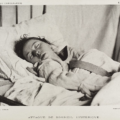The endometriosis patient who elicits from me the greatest form of empathy and compassion is the patient whose pain begins in her teenaged years or even earlier. This young woman has doubts and fears when she thinks her incapacitating symptoms are the norm. She believes that everyone feels as bad as she does during her period (or apart from menses, if her symptoms are not confined to her periods), and so she concludes that other girls handle things better.
She starts to wonder, “Am I a wimp? Do I have to live like this for the rest of my life?”
These feelings of inadequacy are deepened by often well-meaning but uninformed people including coaches (“Working out will make your cramps better”), parents (“Your sisters never complained like you do about this”), and girlfriends (“Don’t be such a baby! It’s just your period!”). Many times the afflicted teenager grits her teeth and tries to tough it out.
When her symptoms do not improve, or when they worsen, the teenager may finally be taken to a doctor, where she may experience her very first pelvic exam. If this examination is not very carefully performed, the experience can be both humiliating and painful. After the exam, the patient may be told, “Everything appears normal.” The message is, “There’s nothing wrong with you. Why do you complain so much?”
If her symptoms are felt to be severe enough, the teenager may be initiated into the world of analgesics (pain medications). Repeated visits to the physician may result in numerous different analgesics.
If symptoms persist, the patient is given ovarian suppressants in the form of birth control pills. The result is that an otherwise healthy and normal young woman is now functioning only with the help of her drugs.
Our society in general frowns on drugs, and teenagers today have especially been inundated with the message, “Just Say No!” This concept contrasts with the young woman’s drug dependency (not drug addiction) and can contribute to a gradual loss of self esteem.
She may think, “I shouldn’t take drugs, but I can’t function without them, therefore I am weak or helpless or worthless or bad.”
As endometriosis progresses in these young women, most eventually end up on the operating table for diagnostic procedures. The endometriosis is diagnosed (sometimes) and staged (sometimes). If the physician believes that there is no cure for this devastating disease, he or she may offer only analgesics or medical forms of therapy (Danocrine, Lupron, Synarel or Zoladex) which stabilize the process at great monetary expense and side effects that can be as bad as the disease itself.
The ultimate result here is that, in addition to all the other physical and psychological impacts of this type of treatment, it takes away the teenager’s hope that she will ever be pain-free to live a normal life. There is nothing I know that has a greater impact on our lives than the loss of hope. It is a primary form of torture used on prisoners of war. Is it any wonder that we find many of these young women have become angry, depressed, and totally confused?
What Can Be Done?
Thankfully, we have much to offer a young woman with endometriosis.
Make the Diagnosis Early
Young women who do not respond to simple mild analgesics and who have any suggestive findings on physical examination should be laparoscoped. Endometriosis should be considered as a possible diagnosis at any point after a girl has her first period (menarche).
Don’t be Drug-happy
If she has symptoms consistent with a diagnosis of endometriosis, it is crucial that the diagnosis be proved before subjecting a young woman to prolonged bouts of powerful drugs. Sometimes physical abnormalities can cause painful symptoms. Such abnormalities can be corrected surgically and are not helped at all by medications.
Believe the Patient
A young woman’s support group (parents, siblings, schoolmates, teachers, partners, boyfriends and girlfriends, etc.) should believe her when she reports pain and other symptoms. It is really very unusual for a well adjusted child to suddenly begin using complaints of pain to get attention.
Enlist an Expert
Facing a first pelvic examination is a little intimidating for even the most relaxed woman. Imagine, then, how frightening it can be for a young woman, in pain and worried. Find a physician who is interested in treating the entire person: not just a collection of pelvic organs.
Know These Facts!
We are now finding that well-trained surgeons skilled in recognizing all visual manifestations of endometriosis can keep recurrence rates under 20% by completely excising all disease. In the overwhelming majority of cases, surgeons knowledgeable in advanced laparoscopic techniques do not need to make large incisions during surgery. Most patients go home the same day they have surgery.
Certainly, menstrual cramps may persist, and some women will have pain around ovulation. Overall, though, I have found the ability to relieve the pain of endometriosis sufferers is one of the most gratifying things I have ever done.
When chronic pain is relieved, you will see the return of a healthy state of mind. These young women can resume their lives as they ought to be. One young woman’s parents wrote, “Thanks for giving us our daughter back.”
We think the teen-aged years are hard enough without endometriosis making them worse, and are pleased to be able to offer the opportunity for significant and long-lasting pain relief.
About the author: Robert B. Albee, MD, FACOG, ACGE is the Founder of the Center for Endometriosis Care, a COEMIG-designated center of excellence in the treatment of the disease.
Lucine Medical Disclaimer: All material on this web site is provided for your information only and may not be construed as, nor should it be a substitute for, professional medical advice. To read more about our health policy see Terms of Use.



















